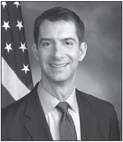Honoring the 70th Anniversary of the Old Guard’s Reactivation

Honoring the 70th Anniversary of the Old Guard’s Reactivation
April 6 marked the 70th anniversary of the 3rd Infantry Regiment's reactivation, and as one of its veterans, I didn't want to let the moment pass without notice. The 3rd Infantry, more commonly known as The Old Guard, serves across the river at Arlington National Cemetery. Most of you here and most of you in the gallery have probably visited the cemetery and seen Old Guard soldiers guarding the Tomb of the Unknowns or conducting funerals. Arkansans who visit me here in the capital consistently tell me that Arlington is a highlight of their trip. That's not surprising to me, because Old Guard soldiers set the standard for their dedication, their diligence, their devotion. The 3rd Infantry is the nation's oldest active-duty infantry unit, and yet the reverence we feel for them goes beyond their mere length of service, and to what they represent: the dignity of freedom.
On April 6, 1948, the 3rd Infantry was reactivated on orders of the Secretary of the Army. The ceremony was held just a few steps from here, on the east plaza of the Capitol. Then The Old Guard immediately conducted another ceremony to present the 'Flag of Liberation' to the President Pro Tempore of the Senate and the Speaker of the House. That flag had flown over this very Capitol on Pearl Harbor Day, December 7, 1941. And then U.S. forces raised that flag over Rome, and Berlin, and Tokyo after we had defeated the Axis powers. Finally, The Old Guard led the large Army Day parade from the Capitol down Constitution Avenue, where President Truman sat in the reviewing stand at the Ellipse.
Not bad for their first day back with the regimental colors. It had been only 18 months since the regiment, serving with the 106th Division as an occupation force in Berlin, was caught up in the rushed demobilizations at the end of World War II. But the Army needed an official ceremonial unit in the nation's capital, as well as a contingency force as tension built between the United States and the Soviet Union. So the Army called the 3rd Infantry back into service at Fort Myer-right next to Arlington-and restored 'the history formerly belonging' to the legendary regiment.
That was due, in no small part, to the regiment's reputation for professionalism, present from its very beginning. The 3rd Infantry was stood up in 1784, when the Continental Congress created the First American Regiment. The War for Independence had convinced Congress that, whatever its fear of standing armies, the country needed at least a small professional fighting force to defend it. And so, the 3rd Infantry started as the lone professional regiment in the early days of our republic, when our common defense was organized mostly around state militias. And to this day, its members continue to display that professionalism by holding themselves to the most exacting standards as the Army's highest- profile unit and the official escort to the president.
But the 3rd Infantry's professionalism also had a serious purpose: to defend America. So faithfully has the regiment served the American people that its history and the nation's history are thoroughly intertwined.
First, it served at posts along the frontier, where it protected American settlements against Indian attacks, under the leadership of General 'Mad' Anthony Wayne, and it fought the British imperial army to a standstill during the War of 1812. Today, members of the regiment wear a buff strap on their left shoulders to commemorate that 18th-century heritage. After the war, peacetime demobilization and reorganization gave the regiment its current name, the 3rd Infantry.
Then, during the Mexican War, the 3rd Infantry distinguished itself with bravery, skill, and stamina at every major battle of the war, in places like Palo Alto, Monterrey, and Vera Cruz. Its famed bayonet charge at the Battle of Cerro Gordo is what persuaded the War Department in 1922 to authorize the 3rd Infantry to march with bayonets fixed to their rifles-a privilege still reserved solely to that regiment in the entire United States Army. And it was because of the 3rd Infantry's valor that General Winfield Scott, the commanding general of the Vera Cruz campaign, granted it the honor of leading the victorious march into Mexico City, during which he turned to his staff, as the 3rd Infantry passed in review, and said, 'Gentlemen, take off your hats to the Old Guard of the Army.' And ever since, the name has stuck.
After the Mexican War came the Civil War, which divided not only our nation, but also our Army. Ulysses S. Grant and Robert E. Lee, who both fought alongside The Old Guard in Mexico now faced off against each other. The 3rd Infantry fought every major battle in the wars' first two years: First Bull Run, Second Bull Run, the Seven Days Battle, Antietam, Fredericksburg, Chancellorsville, and finally Gettysburg. Suffering casualties that exceeded its original strength, The Old Guard ended the war at the Union's mobile headquarters, standing alongside General Grant at Appomattox Court House as he accepted General Lee's surrender.
In the days that followed, the vast majority of state volunteers returned home to their families. Not The Old Guard. The 'regulars,' as they were known back then, went straight back to the front, again protecting settlers from Indian raids across the western frontier. They defeated Spanish forces in Cuba during the Spanish-American War. They fought rebel insurgents in the Philippines, and then returned to fight Muslim insurgents there, too-in some of the same places where the Islamic State is present today. They guarded our border with Mexico during World War I. And they helped get the Lend-Lease program going in the early days of World War II, before deploying to Europe itself.
But it was after The Old Guard's reactivation that it assumed the duties for which it's rightly famous today: performing ceremonies and military-honor funerals. For its first 162 years, The Old Guard defended America's frontiers and fought its wars, both at home and abroad. Now, these new responsibilities have defined The Old Guard's mission for the last 70 years. The size and structure of the regiment has evolved, just as Arlington National Cemetery itself has grown. And The Old Guard's prominence has increased as it participated in major, internationally televised events such as the ceremony to inter the unknown soldiers from World War II and the Korean War in 1958 and the state funeral for President Kennedy in 1963. But the essence of the mission has not changed since 1948.
It's this history, this reliability, this steady, sober leadership that The Old Guard has become known for. Their skill and proficiency, their care and attention to detail, their faithfulness and discipline-all of them set the highest standards of military conduct and character. Our fellow Americans see all that whenever they visit Arlington, they can imagine it on the battlefield, and then they have little wonder why our soldiers accomplish such amazing feats of valor.
That's why The Old Guard is held in such reverence, and that's why it's fitting to mark this important anniversary. The Old Guard represents the best of our country but also the best in ourselves. Freedom isn't free. It requires self-sacrifice and self-discipline. That's what makes it a noble and therefore a fulfilling way of life. And for reminding us of that dignity, the dignity that comes with being a free people, the men and women of the Old Guard deserve our deepest thanks.

From U.S. Senator Tom Cotton


Share